Decorative ceiling beams transform ordinary spaces into extraordinary architectural showcases, adding character, warmth, and visual interest to any room. These versatile design elements offer endless possibilities for creating stunning focal points while enhancing both traditional and contemporary interiors. From rustic reclaimed barn wood to sleek modern steel, ceiling beams serve as powerful design tools that define spaces, create intimate atmospheres, and showcase personal style. Whether you choose authentic materials or budget-friendly alternatives, the right beam design can dramatically elevate your home's aesthetic appeal and increase its value.

1. Rustic Reclaimed Barn Wood Beams for Living Rooms

Authentic reclaimed barn wood beams bring centuries of character into modern living spaces through their weathered patina, natural nail holes, and distinctive saw marks. These genuine timber pieces, often sourced from century-old barns, showcase unique grain patterns and rich amber tones that develop over decades of natural aging. The irregular surface textures and hand-hewn characteristics create an inviting warmth that pairs beautifully with neutral walls and contemporary furnishings. Installing these substantial beams across a living room ceiling establishes an immediate focal point while adding architectural depth. Their organic imperfections tell stories of American craftsmanship, making each beam a conversation piece that anchors the entire room design.
2. Coffered Ceiling Beams with Grid Patterns

Coffered ceiling designs featuring intersecting wooden beams create sophisticated geometric patterns that elevate formal dining rooms and grand living spaces. This classical architectural technique involves installing beams in precise grid formations, creating recessed square or rectangular panels that add dramatic depth and dimension. The systematic arrangement of thick, substantial beams transforms flat ceilings into stunning visual masterpieces reminiscent of European estates and historic libraries. Rich dark stains or painted finishes can complement existing décor while the geometric precision adds formal elegance. Strategic lighting within each coffered section enhances the three-dimensional effect, creating an impressive ceiling treatment that serves as the room's crown jewel.
3. Whitewashed Farmhouse Kitchen Beams
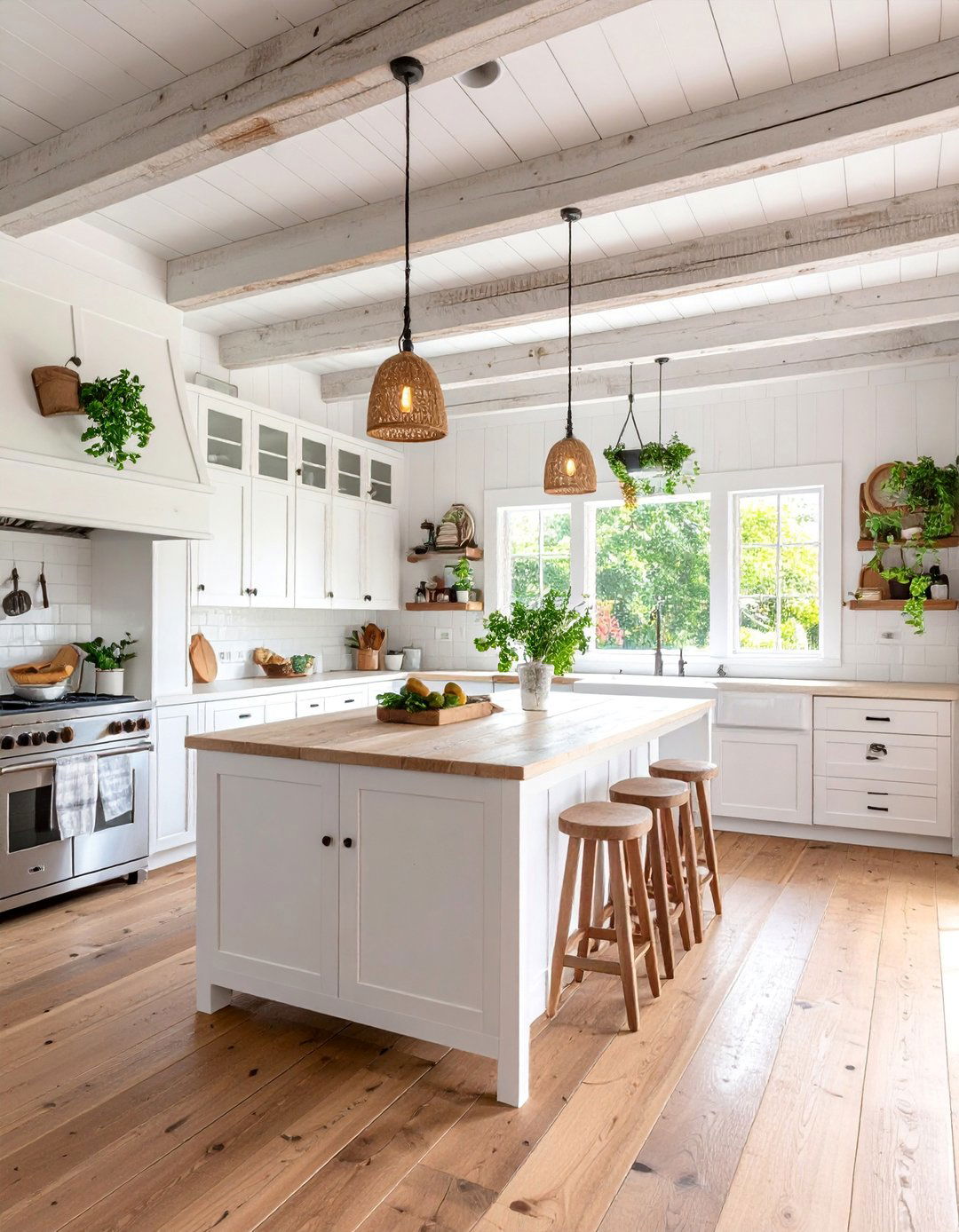
Whitewashed ceiling beams embody the fresh, airy aesthetic of farmhouse design while maintaining subtle wood grain visibility through their translucent finish. This coastal-inspired treatment involves applying diluted white paint or lime wash that allows natural wood texture to show through, creating depth and interest without overwhelming brightness. Perfect for country kitchens and casual dining areas, these beams complement white cabinetry, subway tile backsplashes, and butcher-block countertops. The weathered, lived-in appearance adds authentic charm while reflecting light throughout the space. Paired with mason jar lighting fixtures and vintage accessories, whitewashed beams complete the quintessential farmhouse kitchen that feels both timeless and welcoming.
4. Industrial Black Steel I-Beams

Raw steel I-beams painted in matte black create bold industrial statements perfect for modern lofts, contemporary kitchens, and urban-inspired interiors. These structural-looking elements introduce edgy sophistication through their clean geometric lines and dramatic contrast against white or light-colored ceilings. The metallic finish adds visual weight and anchors open-concept spaces while maintaining an unfinished, warehouse-inspired aesthetic. When combined with exposed ductwork, concrete floors, and Edison bulb lighting, black steel beams complete the industrial design narrative. Their sleek profiles work especially well in minimalist settings where architectural elements serve as primary design features rather than decorative additions.
5. Faux Wood Box Beams for Budget-Friendly Style
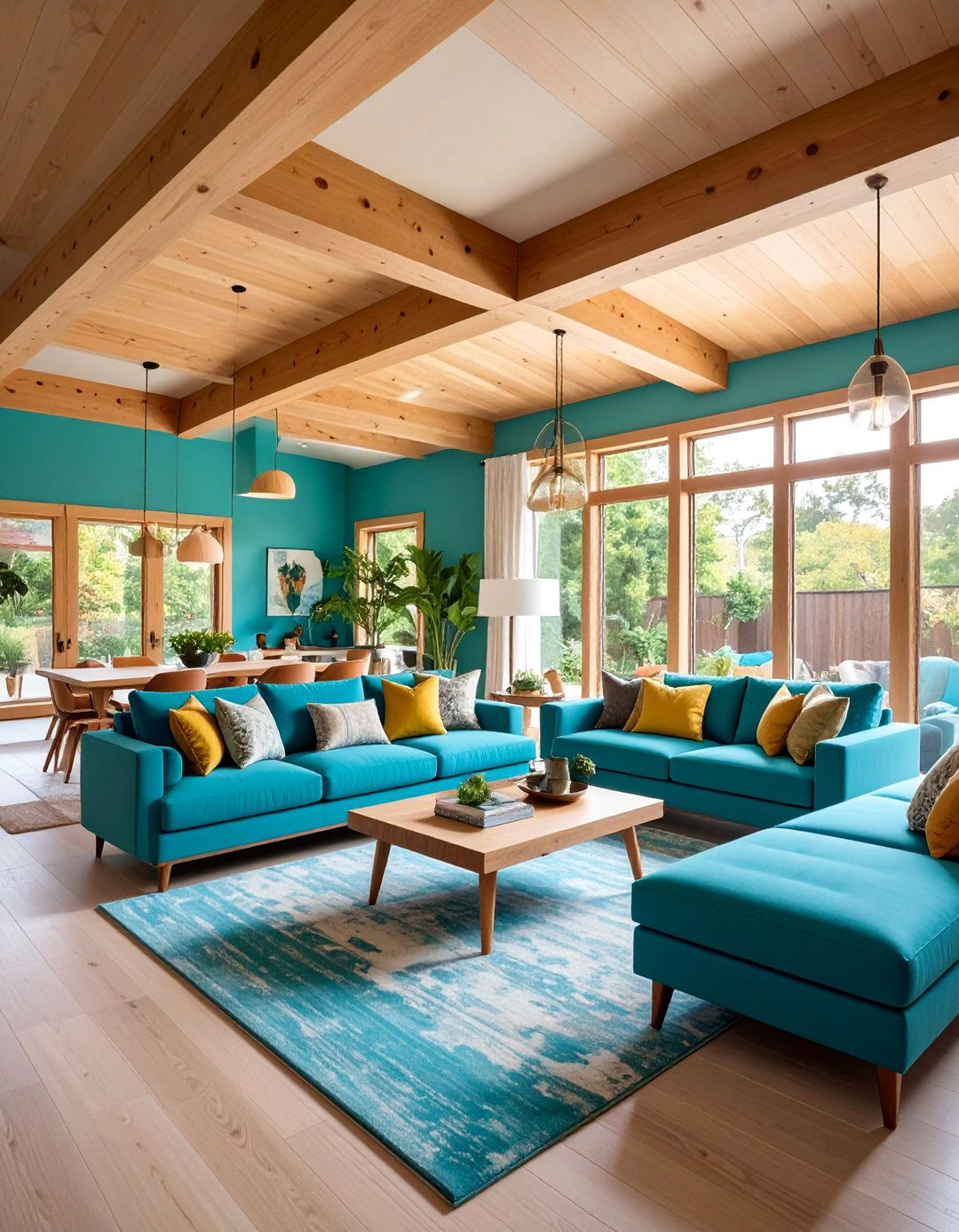
Lightweight polyurethane faux beams offer the authentic appearance of solid timber at a fraction of the cost and installation complexity. These hollow construction elements perfectly replicate wood grain patterns, knots, and weathering effects while remaining significantly lighter than real wood alternatives. The three-sided box design allows easy installation over existing structural elements or drywall, making them ideal for DIY projects and rental properties. Available in numerous stain colors and wood species replications, faux beams provide design flexibility without permanent commitment. Their moisture resistance makes them suitable for bathrooms and kitchens where real wood might warp or deteriorate over time.
6. Dark Stained Cathedral Ceiling Beams
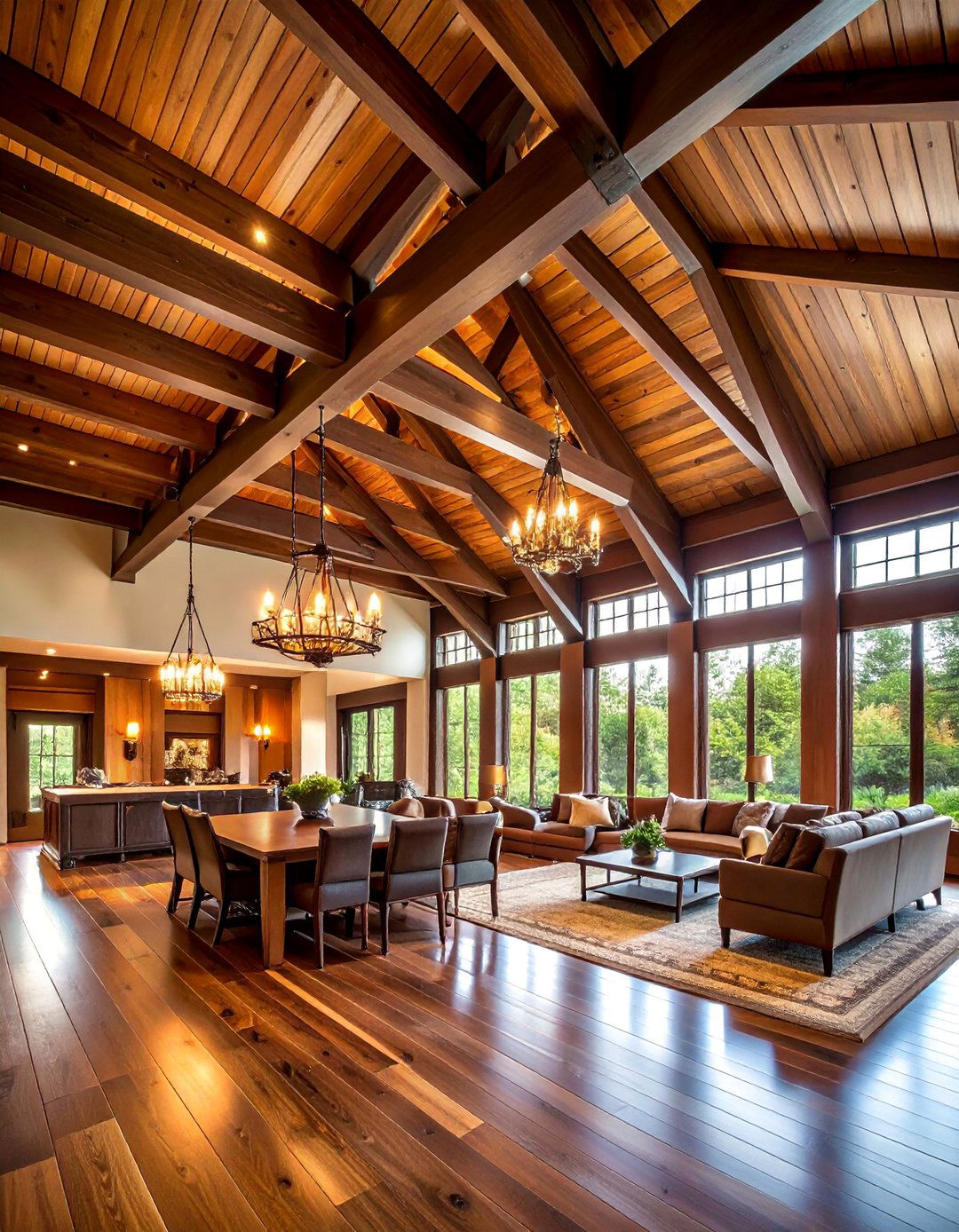
Rich, dark-stained beams following cathedral ceiling angles create dramatic vertical emphasis that draws the eye upward and enhances spatial grandeur. Deep espresso, walnut, or ebony finishes provide striking contrast against light-colored ceilings while adding sophisticated warmth to great rooms and master bedrooms. The angled installation follows natural rooflines, emphasizing architectural bones and creating visual flow from floor to peak. These substantial beams work particularly well in rustic lodge settings, traditional homes, and transitional designs where warmth meets elegance. Strategic placement of recessed lighting between beams illuminates the ceiling plane while highlighting the beam profiles for maximum visual impact.
7. Tray Ceiling Beam Accents
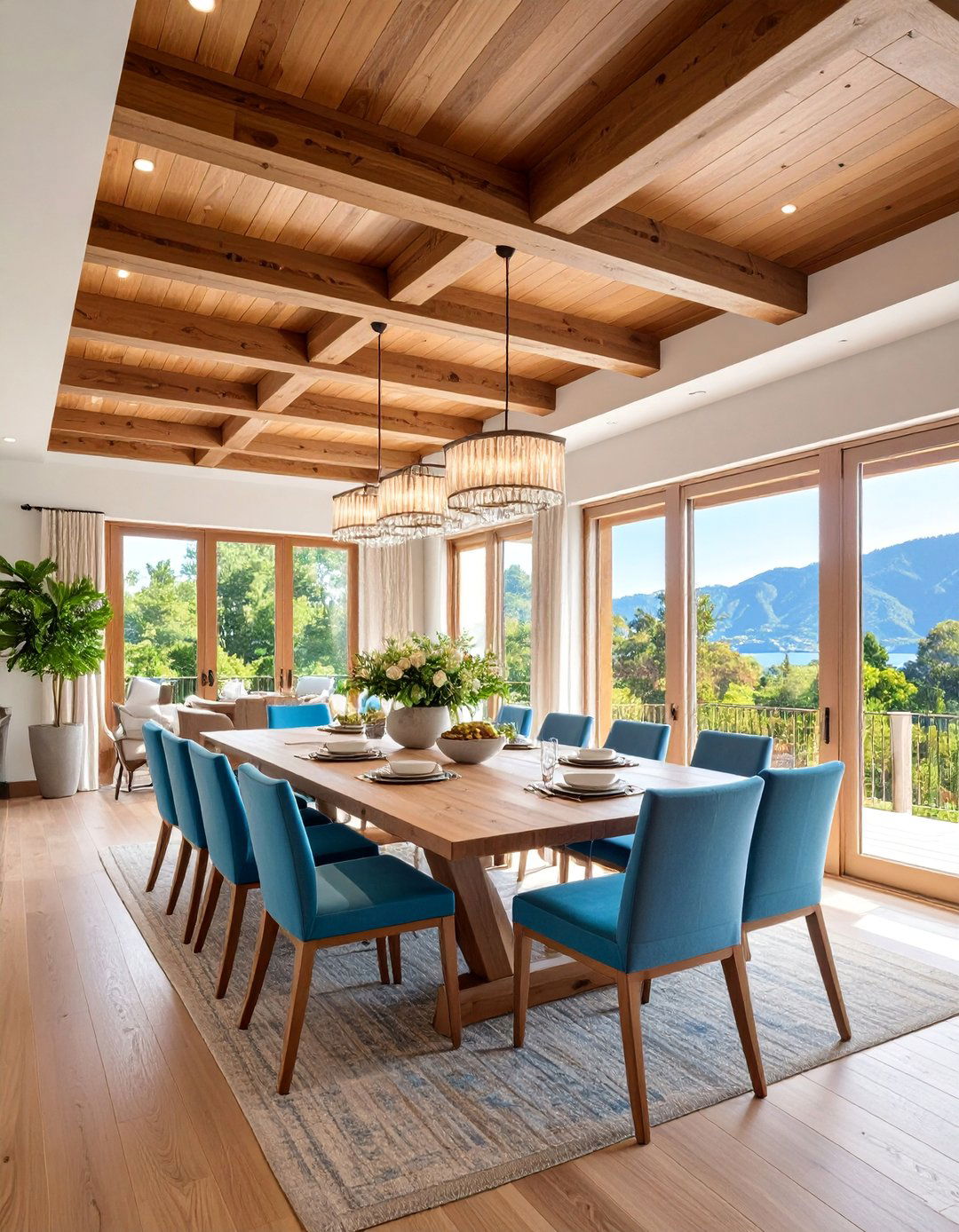
Tray ceilings enhanced with decorative beams create elegant architectural detail perfect for formal dining rooms, master bedrooms, and upscale living areas. The raised center section provides natural boundaries for beam placement, whether outlining the perimeter, creating interior grids, or forming geometric patterns within the recessed area. This design approach adds luxury hotel sophistication while maintaining residential comfort and scale. Painted beams matching trim colors create subtle definition, while contrasting wood tones add dramatic emphasis. Crown molding integration and coordinated paint colors ensure seamless transitions between ceiling planes, resulting in polished, professionally designed spaces.
8. Painted White Modern Ceiling Beams

Crisp white painted beams offer contemporary elegance while adding architectural interest without overwhelming modern interiors. This clean, minimalist approach works beautifully in Scandinavian-inspired spaces, coastal homes, and transitional designs where simplicity meets sophistication. The monochromatic treatment allows beam profiles to create visual texture through shadow and dimension rather than color contrast. White beams reflect light effectively, making rooms feel larger and brighter while maintaining design impact. When paired with white walls and ceilings, subtle variations in paint sheen create depth and prevent the space from feeling flat or sterile.
9. Hand-Hewn Rustic Timber Beams

Authentic hand-hewn beams showcase traditional craftsmanship through visible axe marks, adze cuts, and irregular surfaces that celebrate pre-industrial woodworking techniques. These massive timbers, often reclaimed from barns and historic structures, display the skilled handiwork of craftsmen who shaped each beam individually. The organic surface variations create play of light and shadow that adds visual richness and textural interest to any ceiling application. Perfect for log homes, rustic retreats, and mountain cabins, hand-hewn beams anchor spaces with substantial presence and authentic character. Their irregular profiles ensure that no two installations look identical, providing truly unique architectural elements.
10. Floating Beam Contemporary Design

Sleek floating beams appear to hover without visible support structures, creating modern architectural drama through clean lines and minimal visual weight. This contemporary approach involves concealing mounting hardware and connection points to achieve the illusion of suspended timber elements. The streamlined appearance works particularly well in modern homes where architectural elements serve as sculptural features rather than structural references. Strategic spacing creates rhythm and proportion while maintaining open, airy feelings essential to contemporary design. LED strip lighting hidden above floating beams can create dramatic uplighting effects that enhance the suspended appearance while providing ambient illumination.
11. Cross-Pattern Beam Layouts

Intersecting beam patterns create complex geometric ceiling designs that serve as stunning focal points in grand rooms and formal spaces. This sophisticated approach involves careful planning to ensure proper proportions and visual balance while avoiding overwhelming effects. The crossing beams form squares, rectangles, or diamond patterns that add architectural richness reminiscent of historic castles and manor houses. Strategic use of different beam widths creates hierarchy and visual interest within the overall pattern. This technique works exceptionally well in two-story spaces where the ceiling height accommodates substantial beam dimensions without feeling oppressive.
12. Kitchen Island Defining Beams
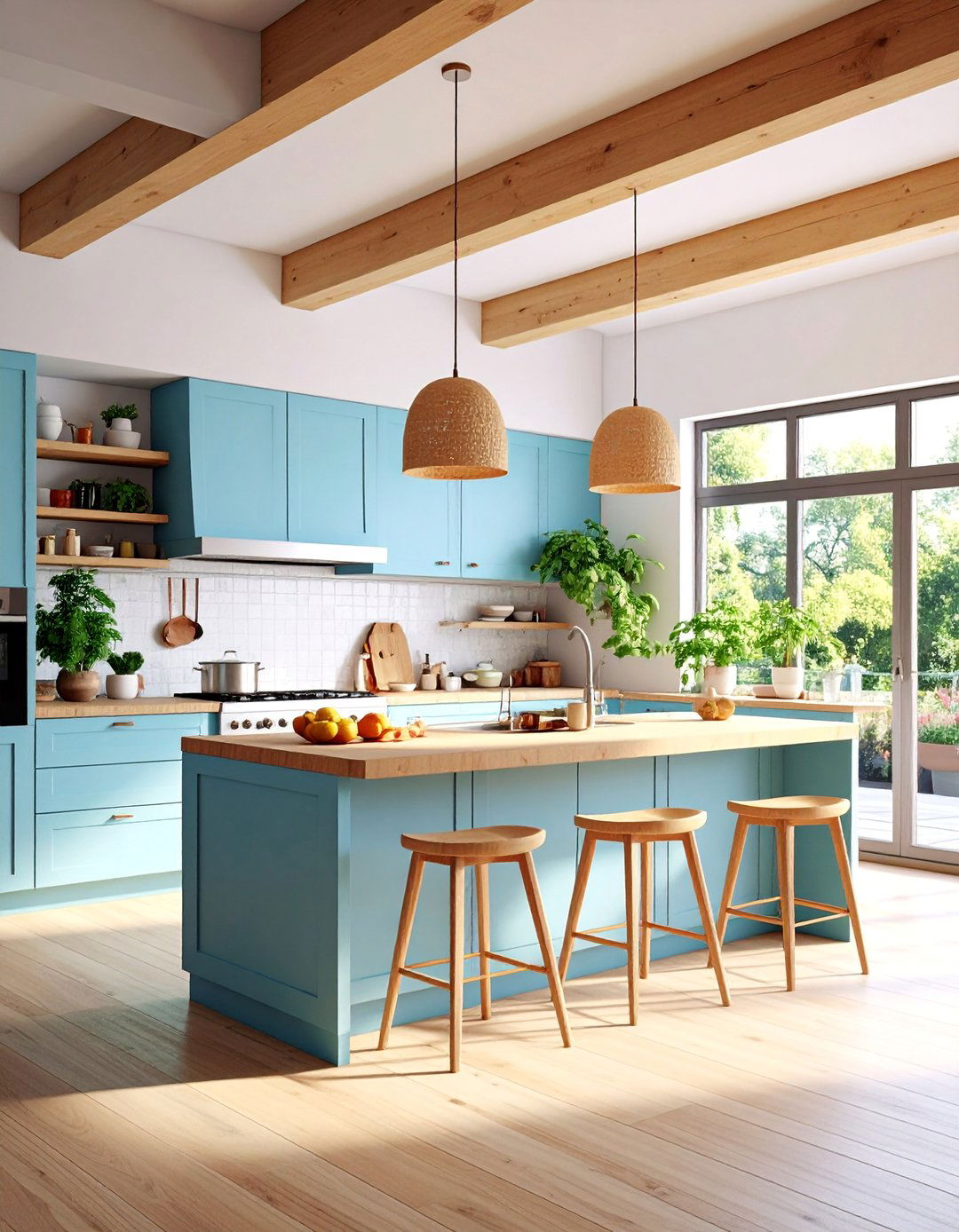
Strategically placed ceiling beams above kitchen islands create natural boundaries that define cooking and gathering spaces within open-concept floor plans. These horizontal elements provide visual separation between kitchen and living areas without requiring walls or physical barriers. The beams serve practical purposes by concealing range hood ductwork, electrical connections, and pendant light mounting while adding architectural definition. Wood species and finishes can coordinate with cabinetry or create intentional contrast for added visual interest. This design approach maintains open sightlines while establishing clear functional zones that enhance both aesthetics and usability.
13. Bedroom Intimate Beam Ceilings
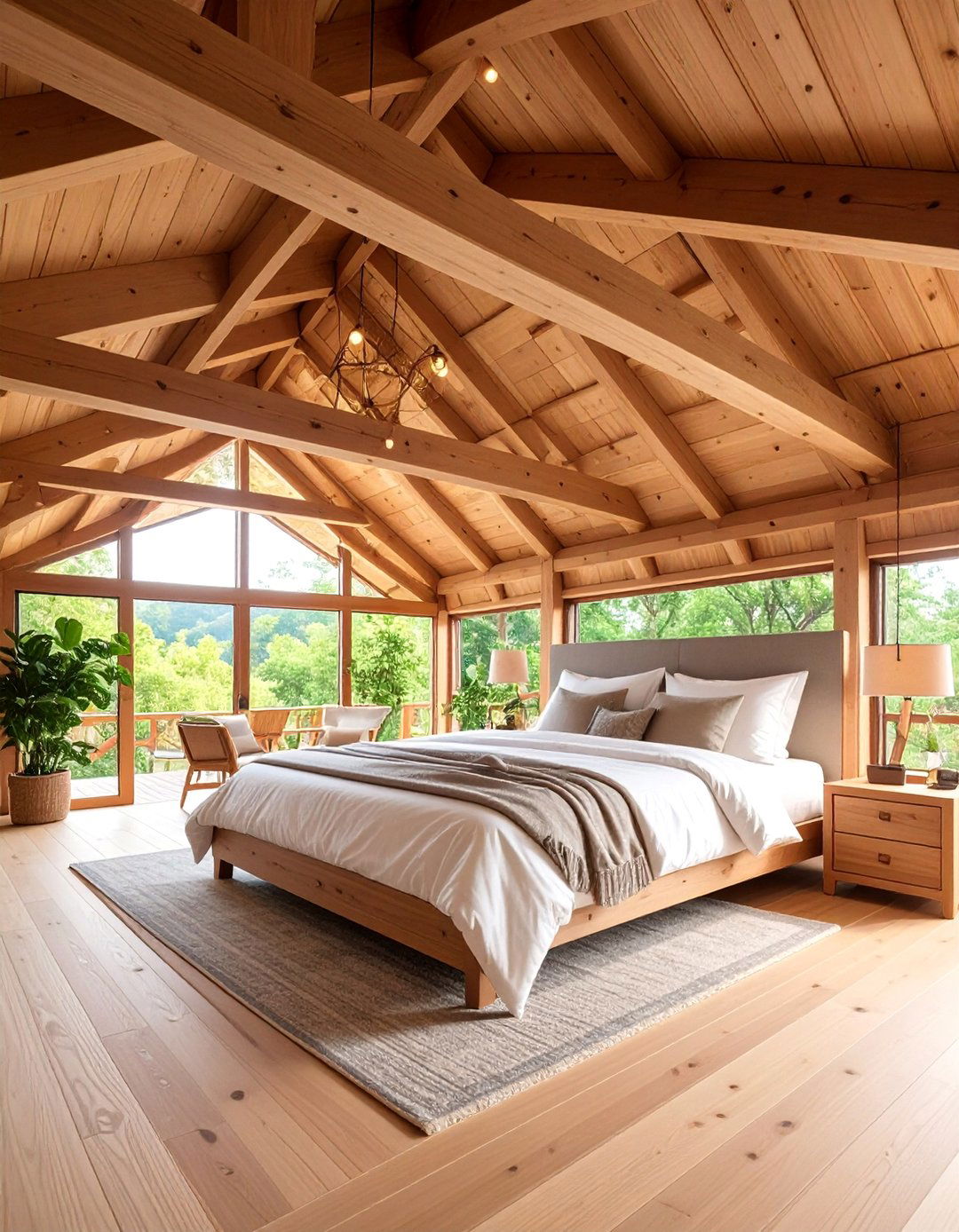
Lower ceiling beams in bedrooms create cozy, intimate atmospheres perfect for relaxation and rest by reducing perceived ceiling height and adding visual warmth. The horizontal elements provide psychological comfort while serving as natural mounting points for reading lights, ceiling fans, or decorative elements. Painted or stained finishes can coordinate with bedding colors and furniture tones to create cohesive, calming environments. This approach works particularly well in master suites and guest rooms where comfort and serenity take priority over dramatic design statements. Soft, warm lighting integrated with beam placement enhances the restful atmosphere essential for quality sleep spaces.
14. Bathroom Spa-Style Ceiling Beams
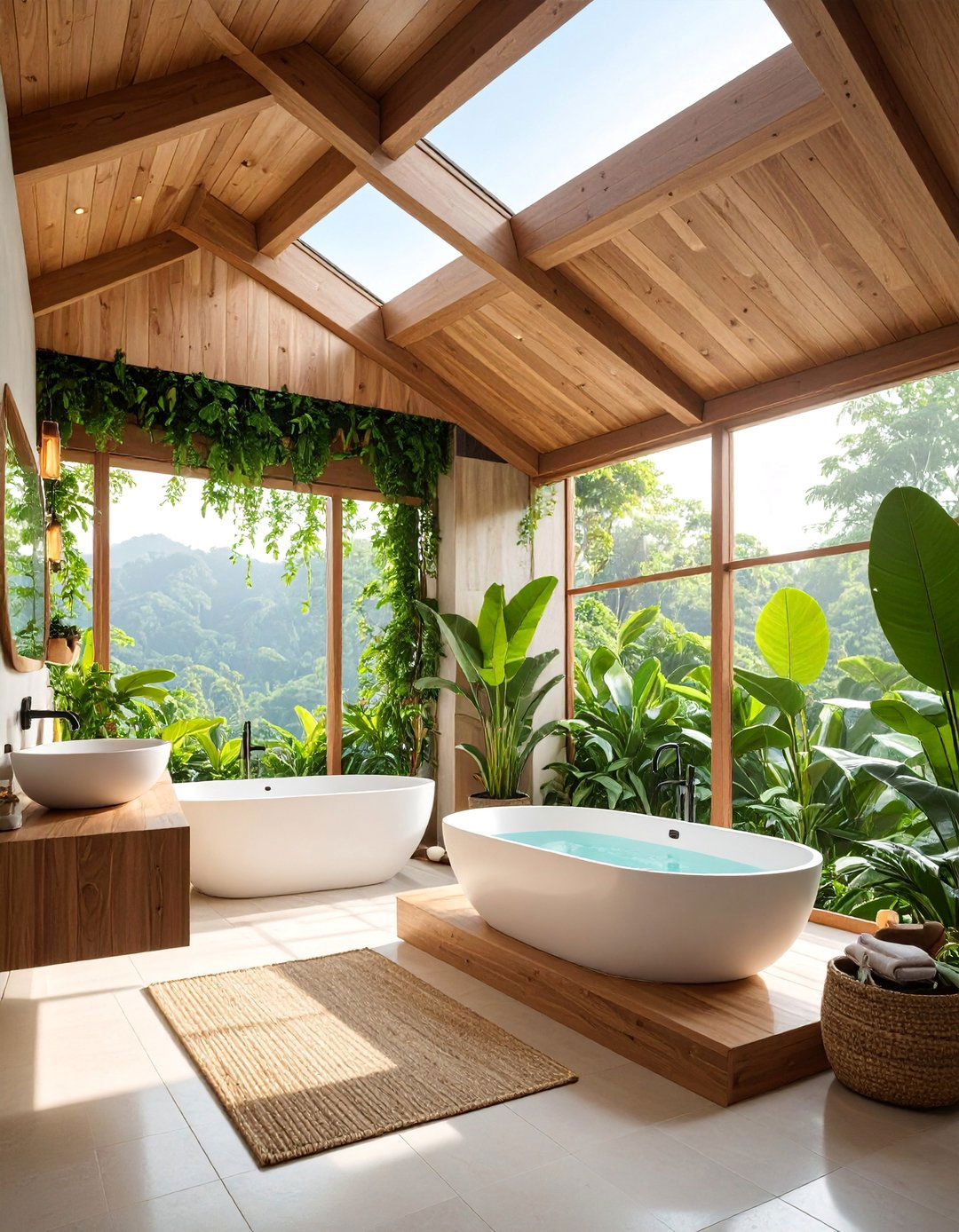
Natural wood ceiling beams in bathrooms create resort-inspired spa atmospheres that transform ordinary spaces into relaxing retreats. The organic textures and warm tones provide contrast to hard tile surfaces while adding visual warmth and natural beauty. Proper sealing and ventilation ensure beam longevity in humid environments while maintaining authentic wood appearance. This design approach works especially well with natural stone, neutral color palettes, and plants to complete the spa aesthetic. Recessed lighting between beams provides task illumination while maintaining the serene, uncluttered feeling essential to successful bathroom sanctuaries.
15. Living Room Statement Beam Features
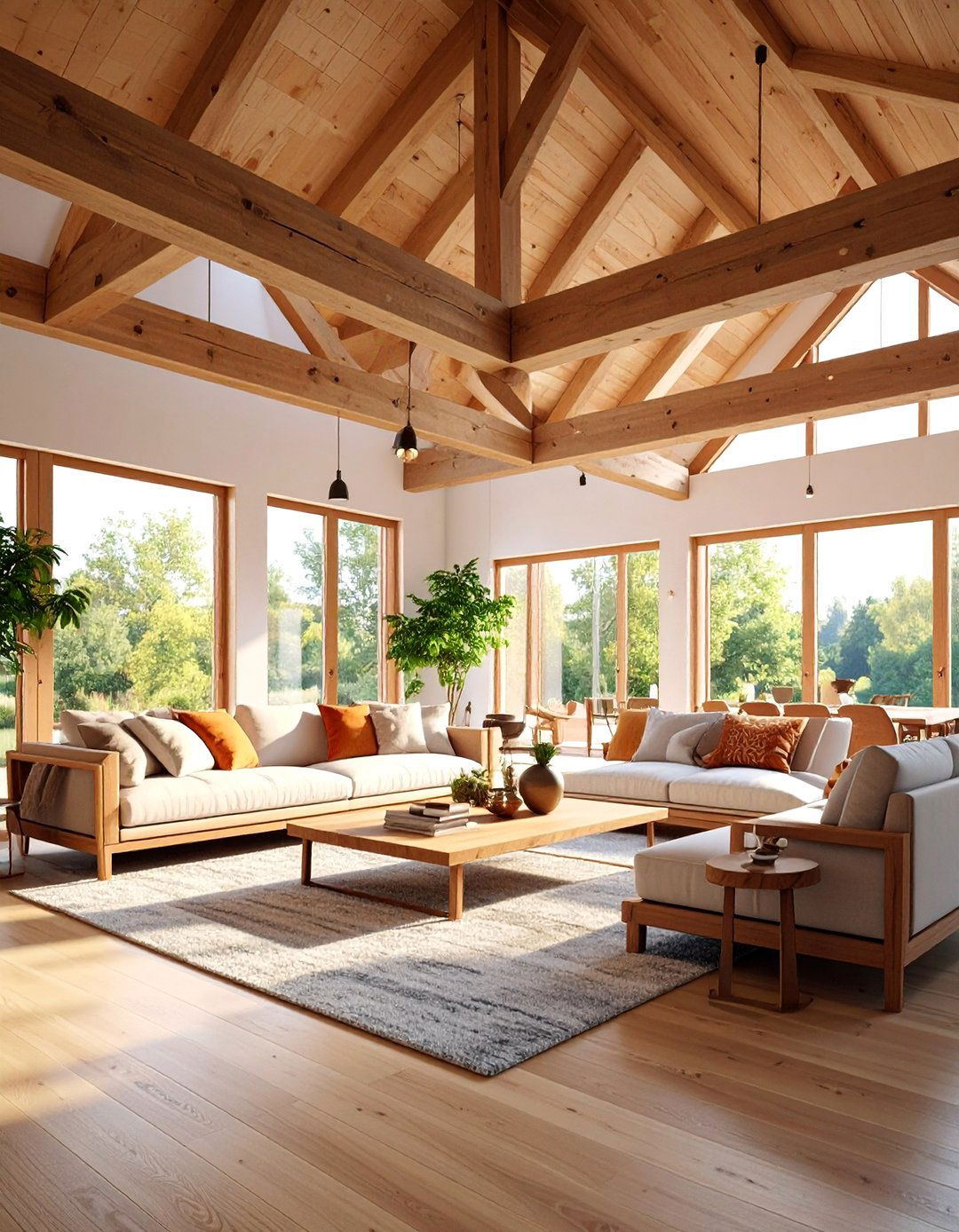
Dramatic oversized beams create powerful focal points that anchor large living rooms and establish design hierarchy within open spaces. These substantial architectural elements provide visual weight that balances large furniture groupings while adding textural contrast to smooth walls and ceilings. The imposing presence commands attention and creates conversation-starting features that define room character. Strategic placement ensures proper scale relationships with existing architectural elements while avoiding overwhelming effects. Rich stains, natural finishes, or painted treatments can coordinate with existing décor to create cohesive design statements that feel both dramatic and harmonious.
16. Limewashed Coastal Ceiling Beams

Limewashed beams achieve perfectly imperfect coastal charm through translucent white treatments that allow wood grain and character marks to remain visible. This traditional European technique creates subtle color variations and organic texturing that cannot be replicated with standard paint applications. The breathable finish allows natural wood movement while providing weather-resistant protection ideal for coastal environments. The resulting appearance suggests years of salt air exposure and natural weathering that authentically captures seaside cottage charm. Combined with whitewashed walls, natural fiber textiles, and sea glass colors, limewashed beams complete the relaxed coastal aesthetic.
17. Decorative Hardware Accent Beams
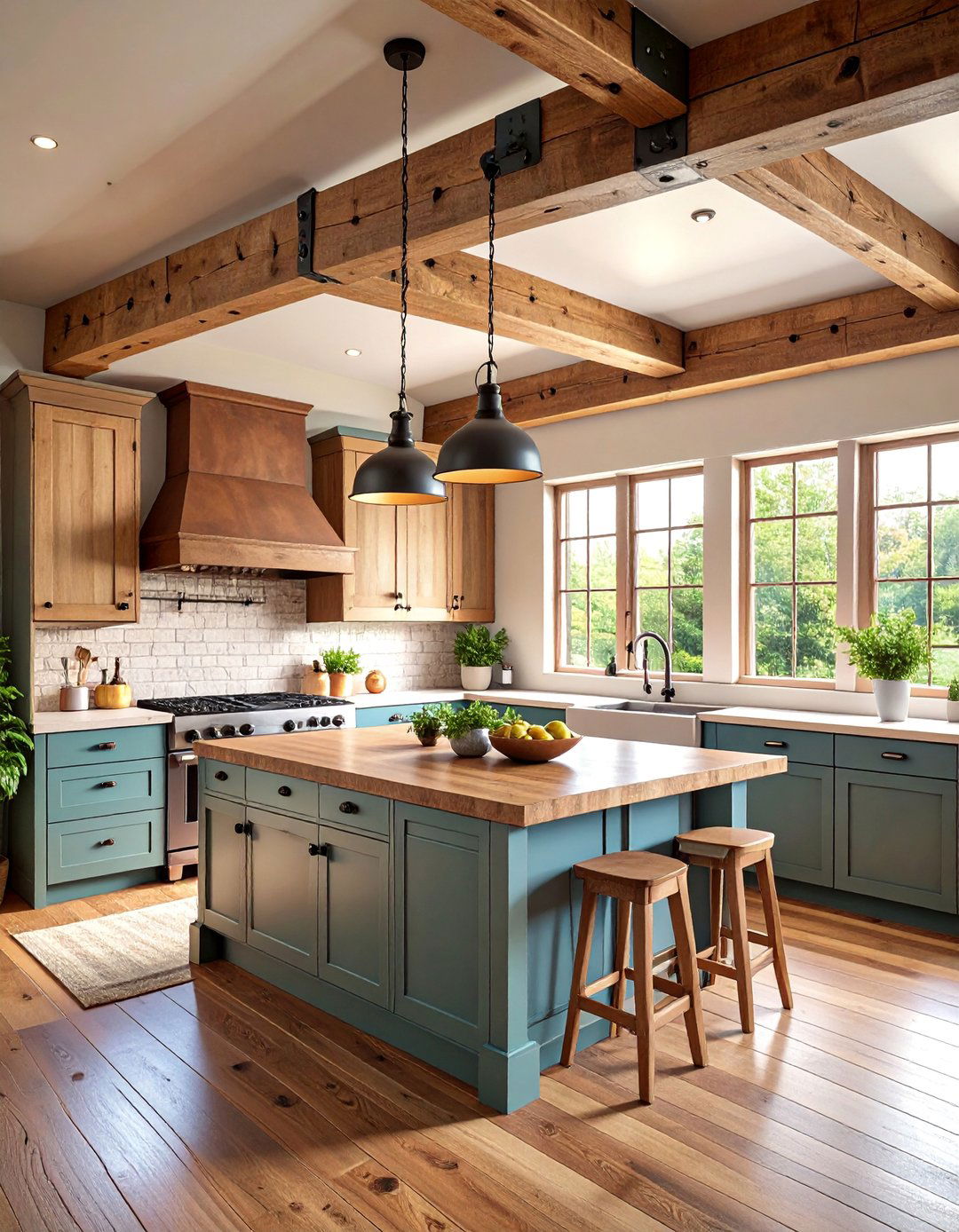
Metal straps, clavos, and decorative bolts transform simple wooden beams into authentic-looking structural elements that reference traditional timber framing techniques. These hardware accents add visual interest and historical reference while creating the illusion of mortise and tenon construction methods. The metallic elements provide contrast against wood tones while suggesting functional purpose beyond mere decoration. This approach works particularly well in rustic, farmhouse, and traditional settings where authentic craftsmanship details enhance overall design credibility. Strategic hardware placement ensures visual balance while maintaining the handcrafted appearance essential to successful execution.
18. Lighting-Integrated Ceiling Beams
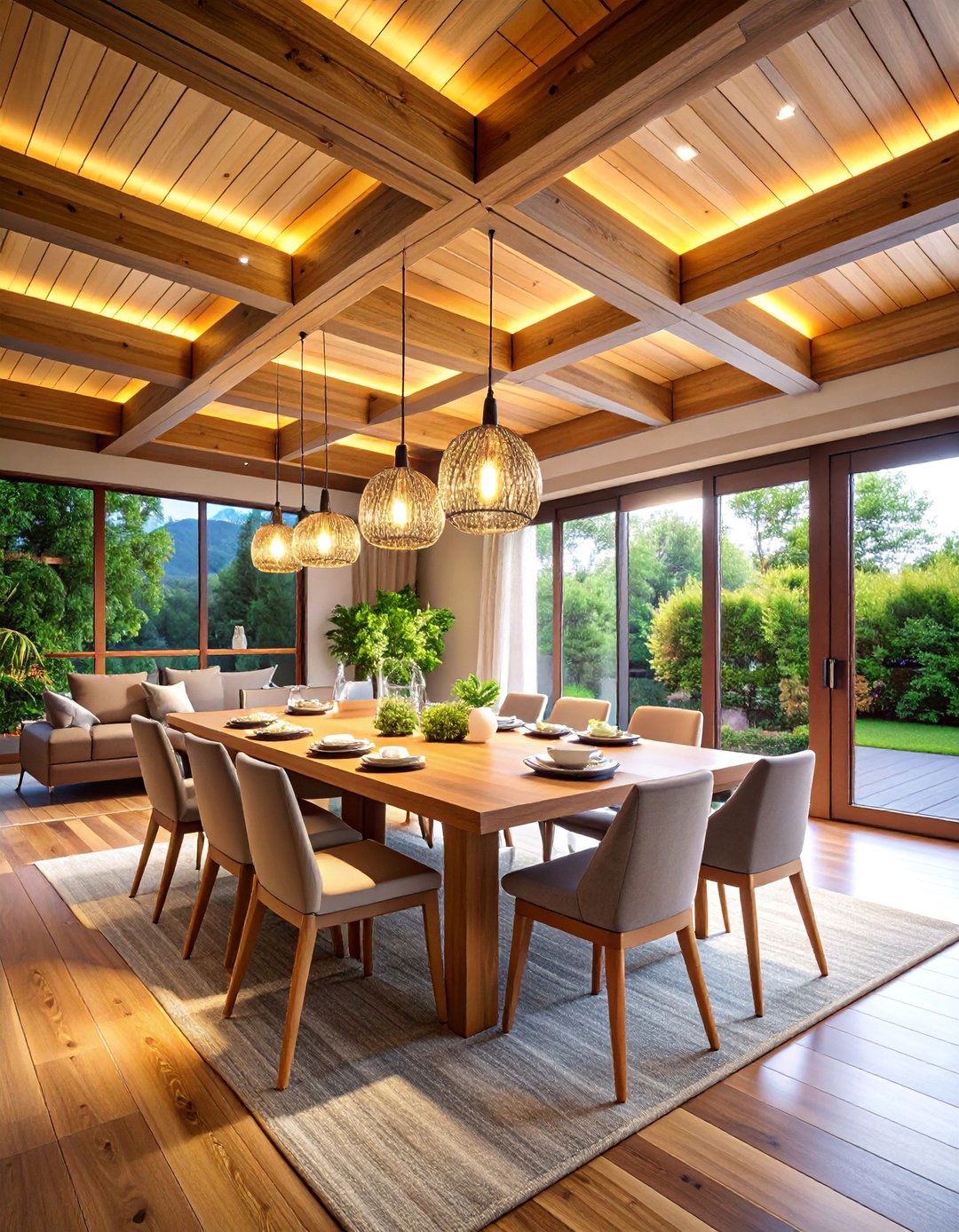
Built-in lighting systems within ceiling beams provide both architectural drama and practical illumination through concealed LED strips, recessed fixtures, or pendant mounting points. This integrated approach eliminates the need for separate ceiling fixtures while creating clean, uncluttered appearances. The beam profiles naturally hide wiring and mounting hardware while providing strategic light placement for optimal room illumination. This technique works exceptionally well in modern and contemporary settings where clean lines and minimal visual clutter take priority. Variable dimming controls allow atmospheric adjustment while maintaining the sophisticated integration of light and architecture.
19. Curved Architectural Beam Designs

Custom curved beams follow arched doorways, barrel ceilings, or architectural elements to create unique design features that celebrate craftsmanship and attention to detail. These specialized elements require expert installation but provide unmatched visual impact through their organic flowing lines. The curved profiles soften angular room geometries while adding sophisticated sculptural elements that distinguish custom homes from standard construction. This approach works particularly well in Mediterranean, Mission, and Arts and Crafts styles where curved elements reflect traditional architectural vocabulary. The organic shapes create visual flow that guides the eye through spaces while adding unexpected design drama.
20. Entryway Welcome Beam Features

Substantial ceiling beams in entry halls and foyers create impressive first impressions that establish home character and design direction for visitors. These architectural elements provide immediate visual impact while suggesting the quality and attention to detail found throughout the home. The beams can coordinate with front door styles, hardware finishes, and exterior architectural elements to create seamless indoor-outdoor transitions. Strategic lighting integration ensures proper illumination for safety and aesthetics while highlighting beam profiles. This design approach works across architectural styles from contemporary to traditional, providing flexibility while maintaining impactful presence.
21. Dining Room Elegant Beam Patterns

Formal dining rooms benefit from sophisticated beam arrangements that create intimate gathering spaces while maintaining elegant proportions suitable for entertaining. The ceiling treatments provide visual definition that separates dining areas from adjacent spaces while creating appropriate scale for furniture placement. Rich wood finishes complement traditional dining furniture while painted options coordinate with contemporary designs. Strategic chandelier placement within beam frameworks creates dramatic focal points while ensuring proper task lighting for dining functions. This approach transforms ordinary dining spaces into memorable rooms suitable for special occasions and daily family gatherings.
22. Barn-Style Truss Ceiling Systems

Complex truss patterns reference agricultural architecture while providing dramatic ceiling treatments suitable for great rooms, family rooms, and rustic retreats. These engineered-appearing systems create visual complexity through angled braces, king posts, and connecting elements that suggest structural purpose. The intricate geometry provides endless visual interest while maintaining open feelings essential to large spaces. This approach works particularly well in homes with rural settings or barn-inspired design themes where authenticity enhances overall architectural credibility. Proper proportions ensure impressive appearance without overwhelming room functions or furniture placement.
23. Modern Minimalist Linear Beams
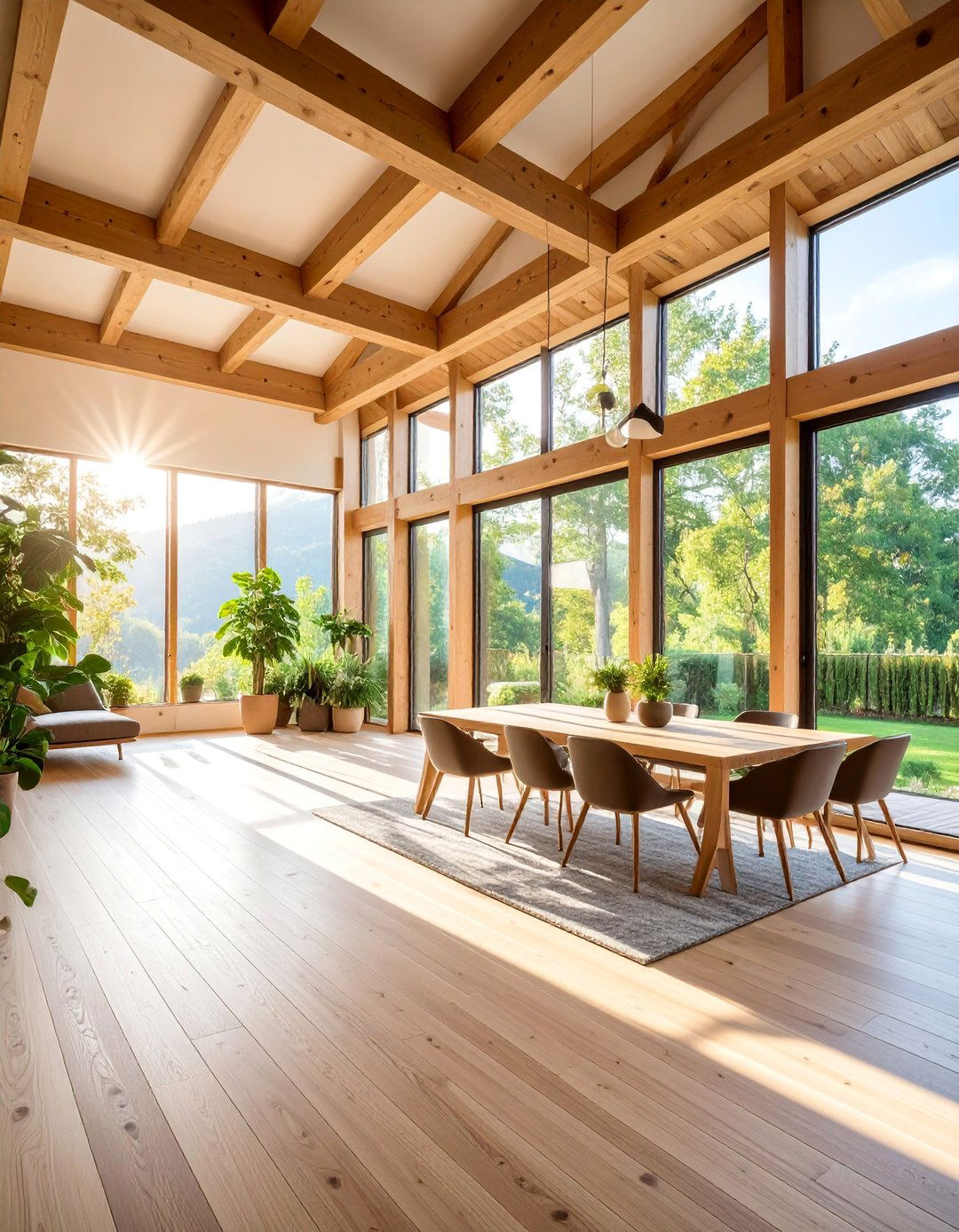
Clean, geometric beam arrangements create contemporary ceiling interest through repetitive spacing, consistent proportions, and monochromatic finishes that emphasize form over ornamentation. This minimalist approach relies on precise installation and careful attention to detail rather than decorative elements for visual impact. The linear repetition creates rhythm and movement while maintaining the clean, uncluttered aesthetic essential to modern design success. Integrated lighting systems can enhance the geometric patterns while providing practical illumination. This technique works particularly well in urban lofts, contemporary homes, and commercial spaces where architectural precision reflects design sophistication.
24. Whitewashed Pine Cottage Beams
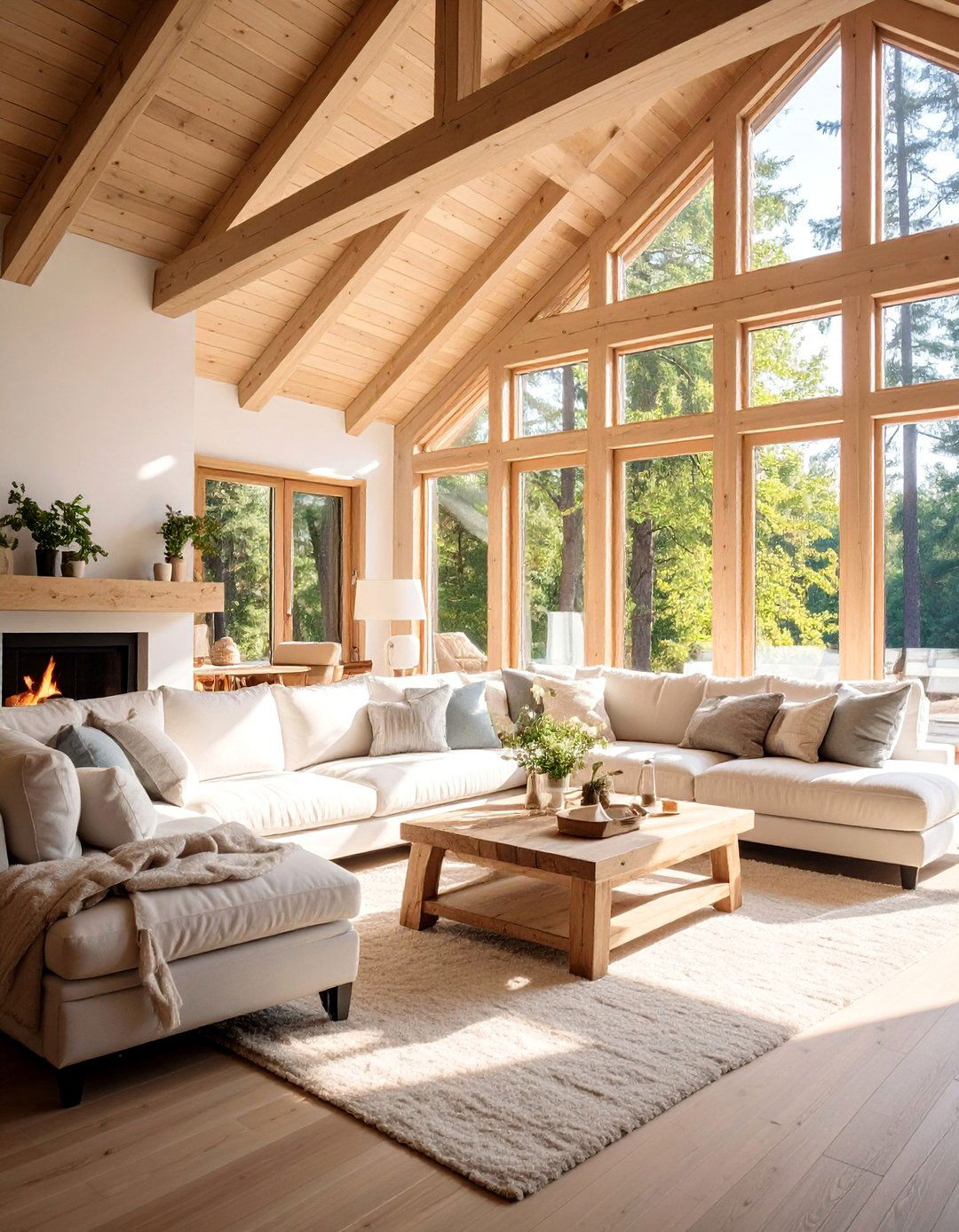
Natural pine beams treated with whitewash finishes create casual cottage charm through light, airy appearances that complement informal living spaces. The translucent treatment allows wood grain visibility while providing subtle color that enhances rather than overwhelms room décor. This approach works particularly well in beach houses, country cottages, and casual family rooms where relaxed atmospheres take priority over formal design statements. The cost-effective pine material makes this option accessible while whitewash treatments ensure longevity and easy maintenance. Combined with casual furnishings and natural textiles, whitewashed pine beams complete comfortable, livable interiors.
25. Mixed-Material Contemporary Beam Combinations
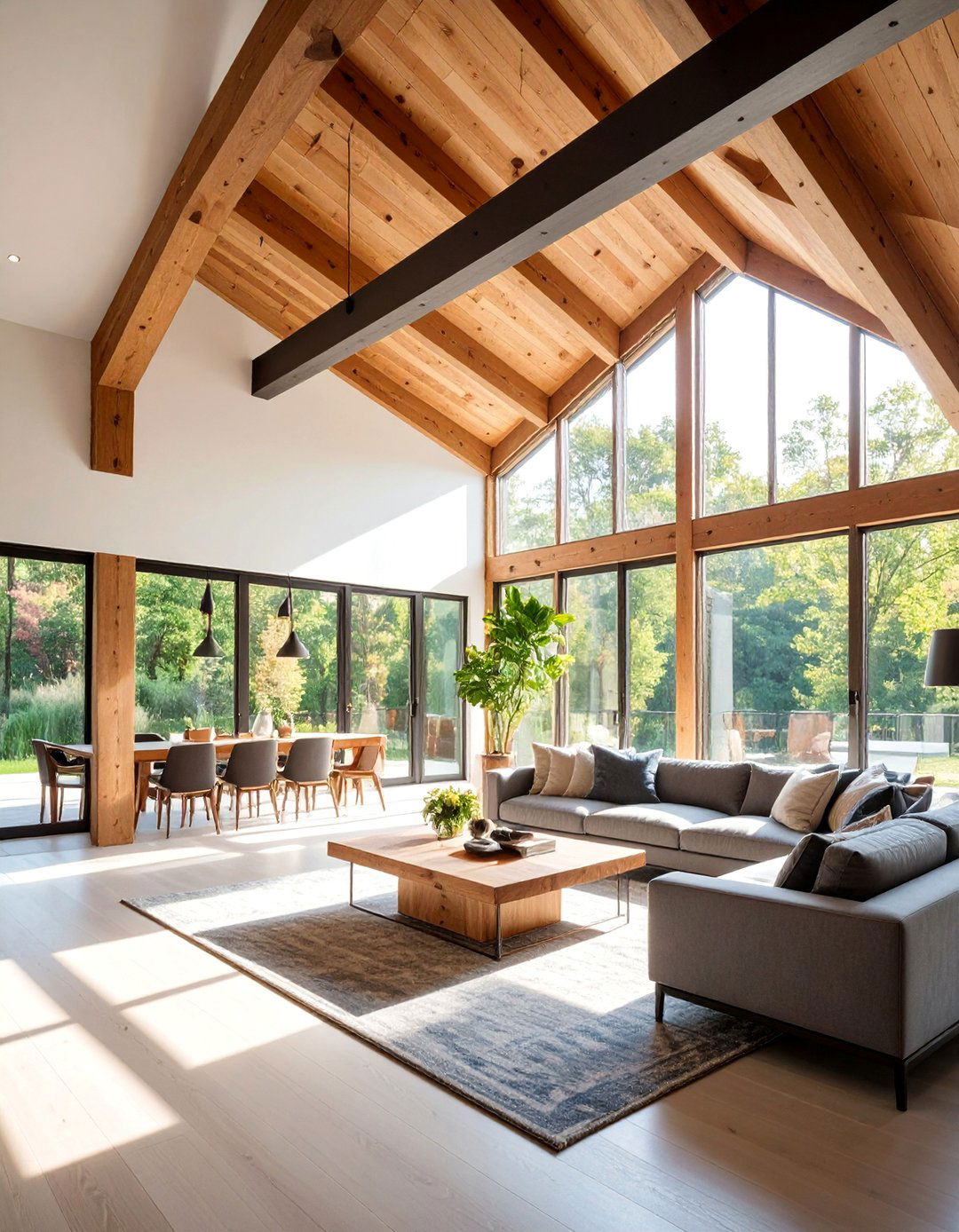
Innovative combinations of wood, steel, and concrete create unique ceiling treatments that reflect contemporary design exploration and material honesty. These hybrid approaches might combine raw steel flanges with reclaimed wood infill or concrete elements with timber accents to create sophisticated architectural statements. The material contrasts highlight individual properties while creating unified design elements that reference both industrial and natural aesthetics. This cutting-edge approach works particularly well in modern homes where material experimentation and architectural innovation reflect owner sophistication and design awareness. Proper detailing ensures successful integration while maintaining structural integrity and visual coherence.
Conclusion:
Decorative ceiling beams offer transformative design potential that extends far beyond mere ornamentation, serving as powerful architectural tools that define spaces, create atmospheres, and reflect personal style preferences. From authentic reclaimed materials to innovative contemporary combinations, the right beam selection can dramatically enhance any interior while providing lasting value and visual appeal. Whether pursuing rustic charm, modern sophistication, or traditional elegance, these versatile elements adapt to countless design scenarios while maintaining their fundamental ability to elevate ordinary rooms into extraordinary spaces.



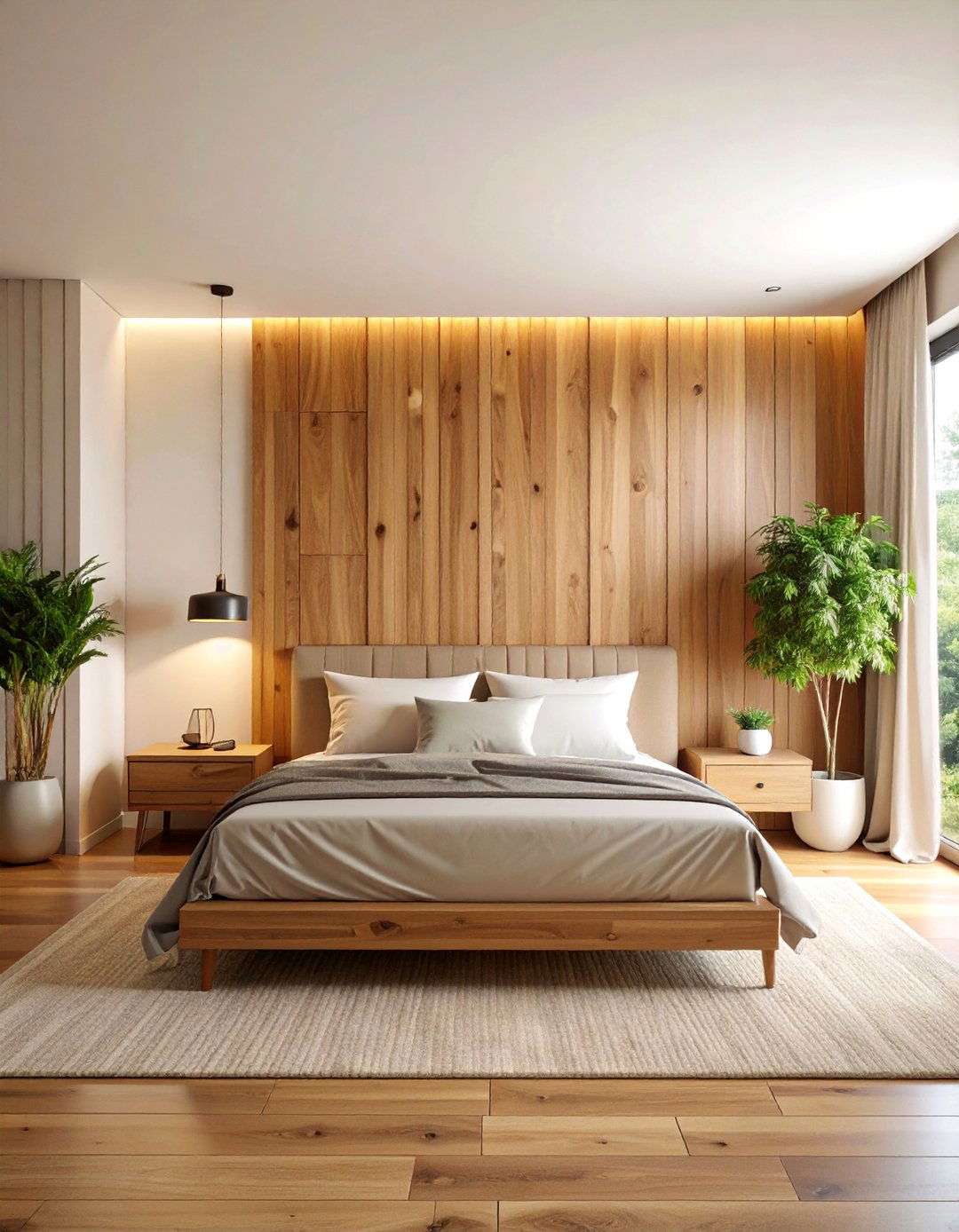
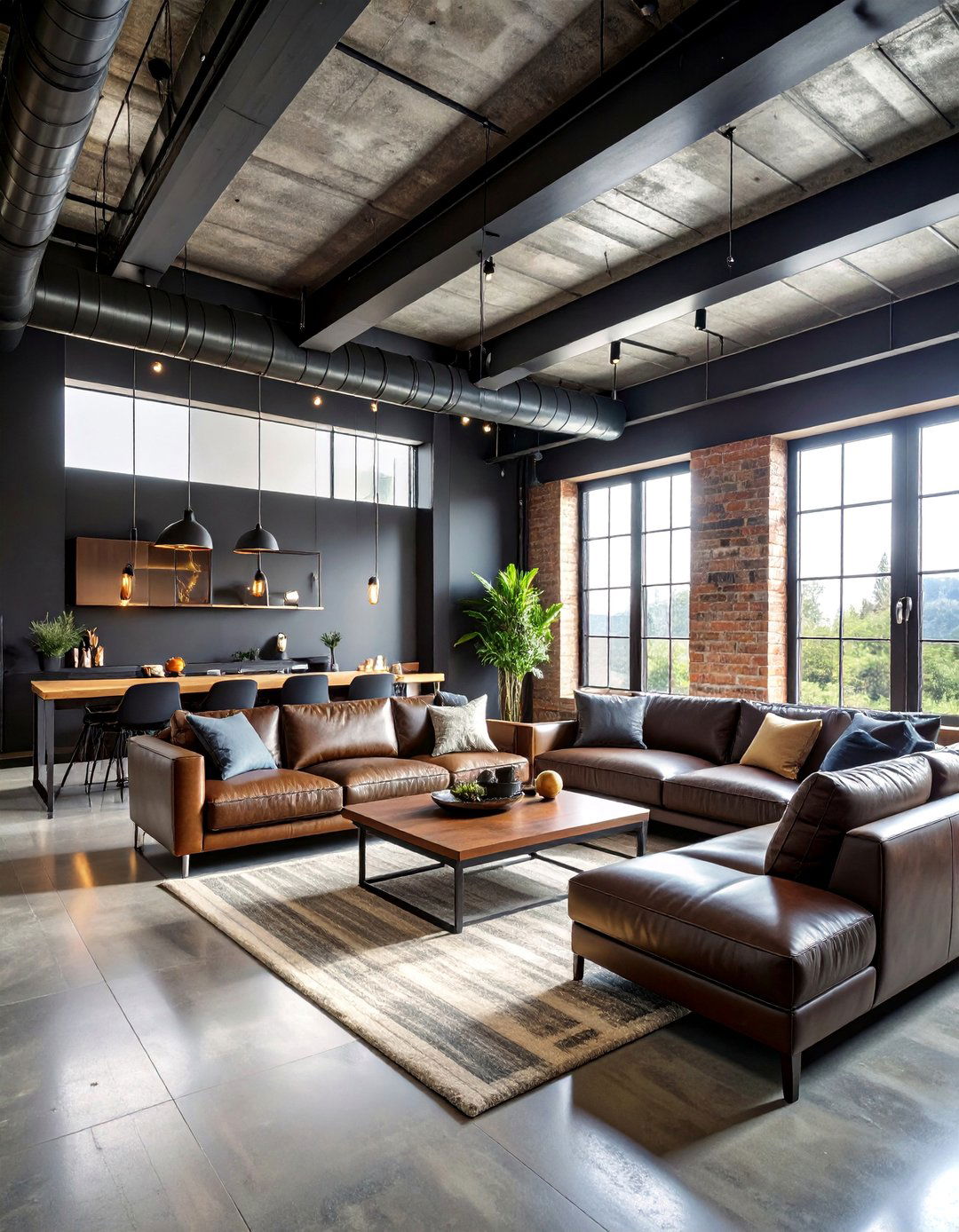
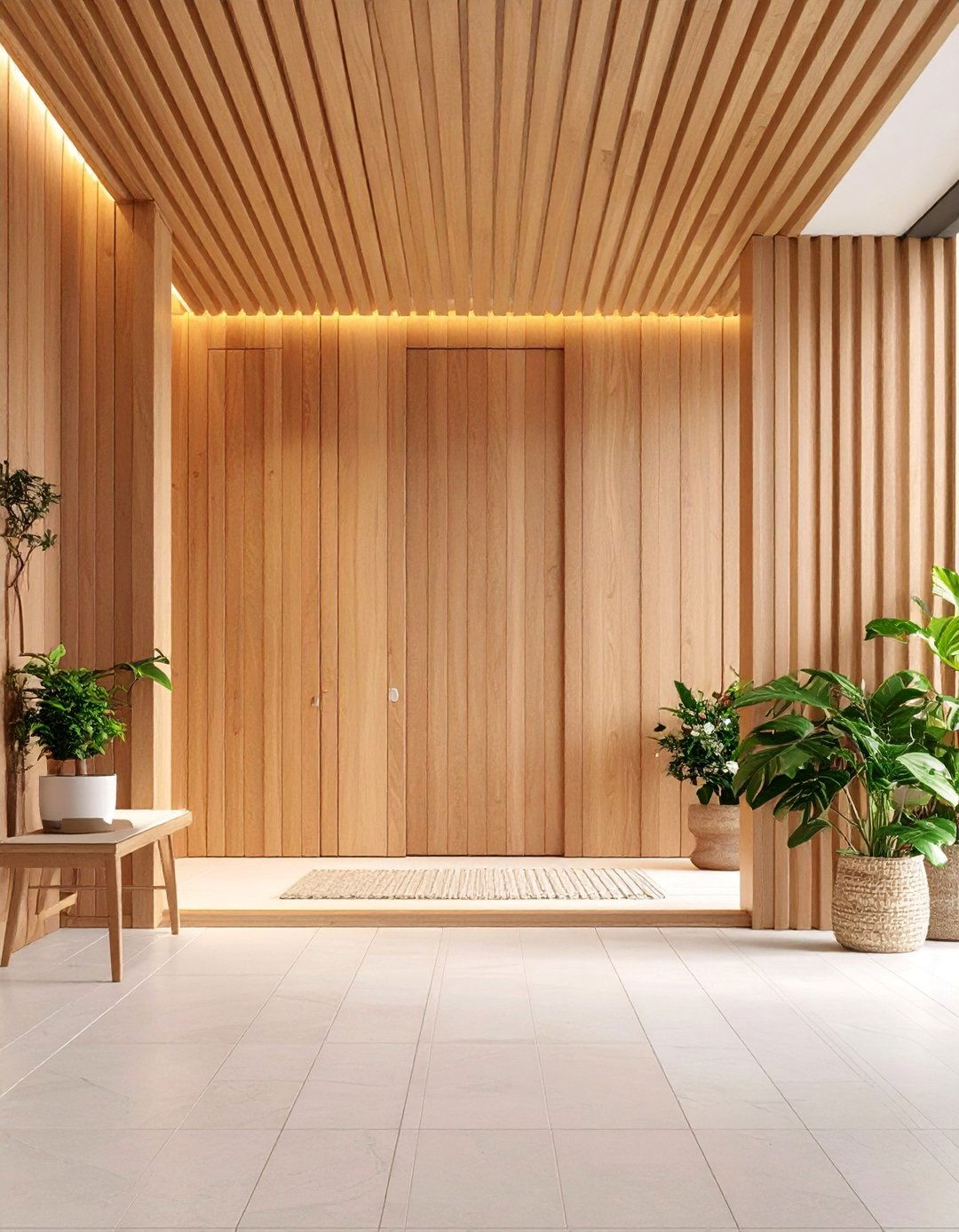


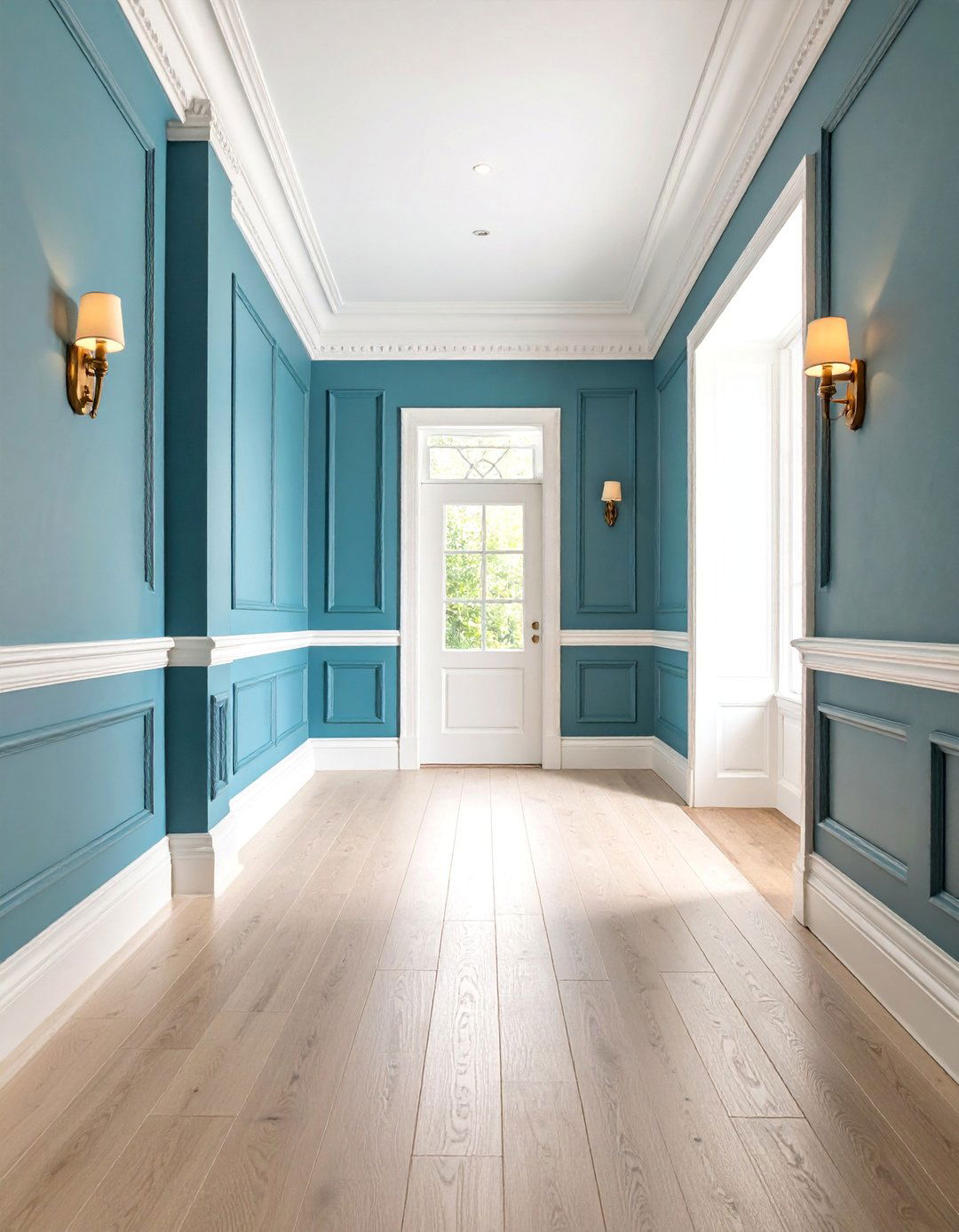
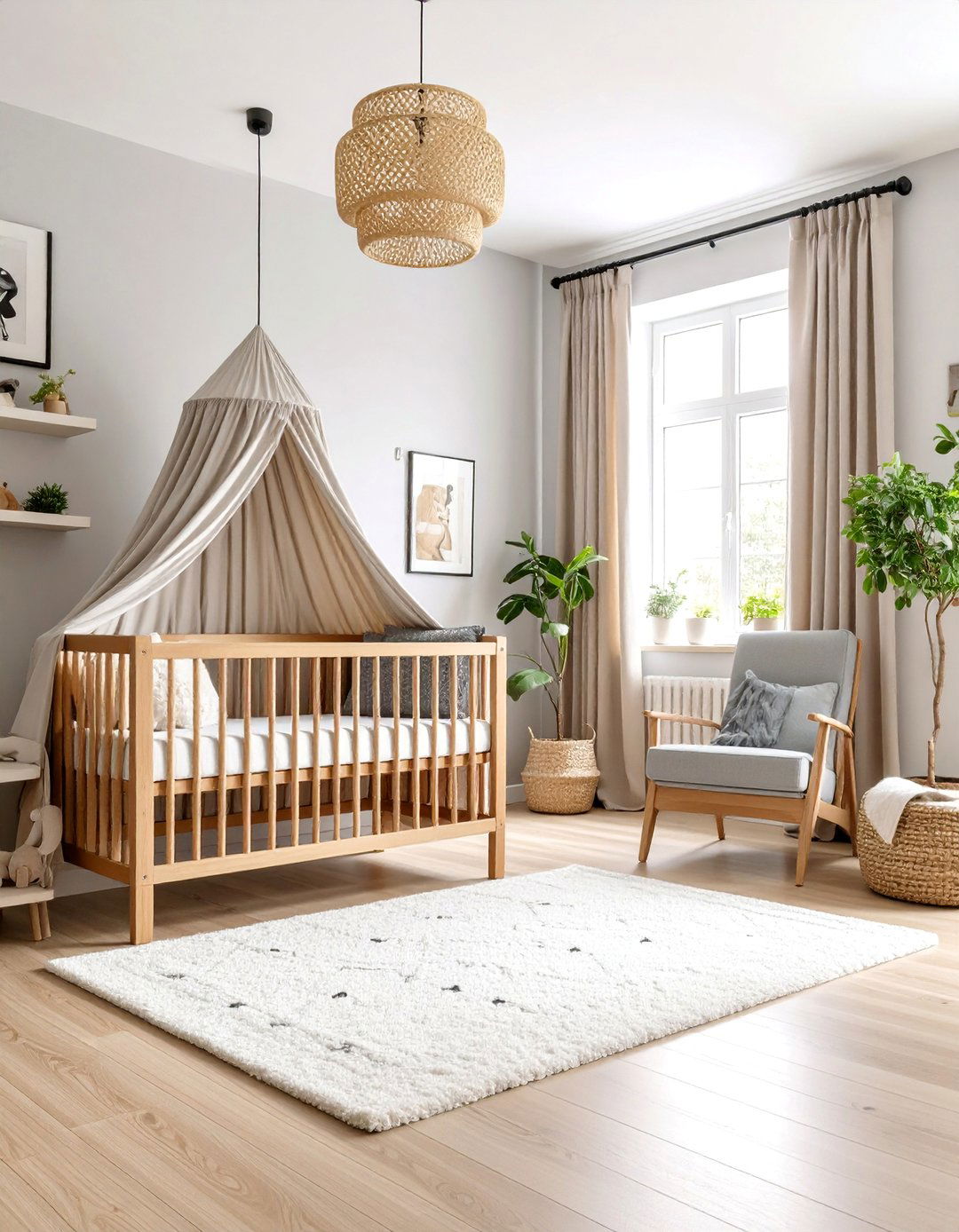
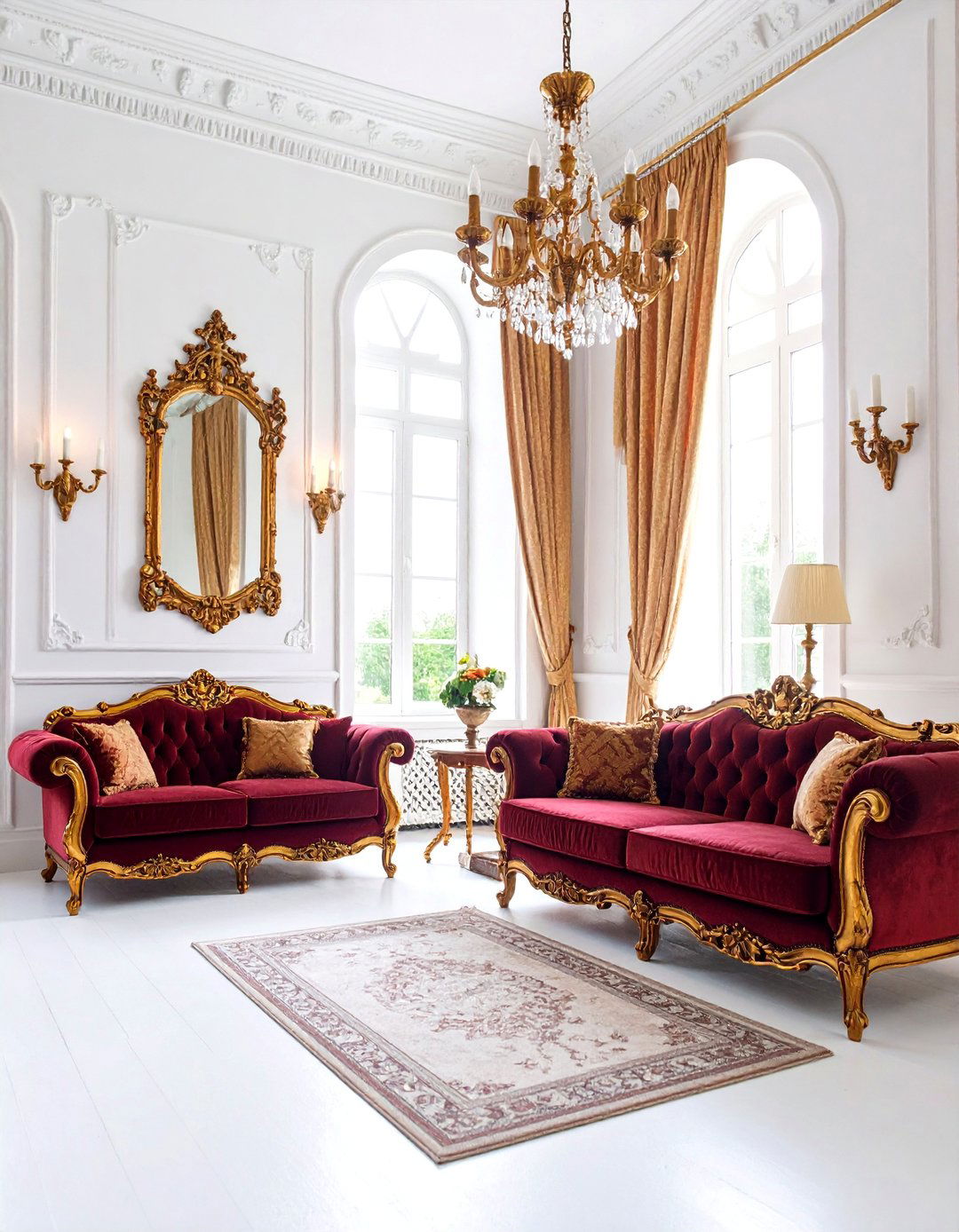

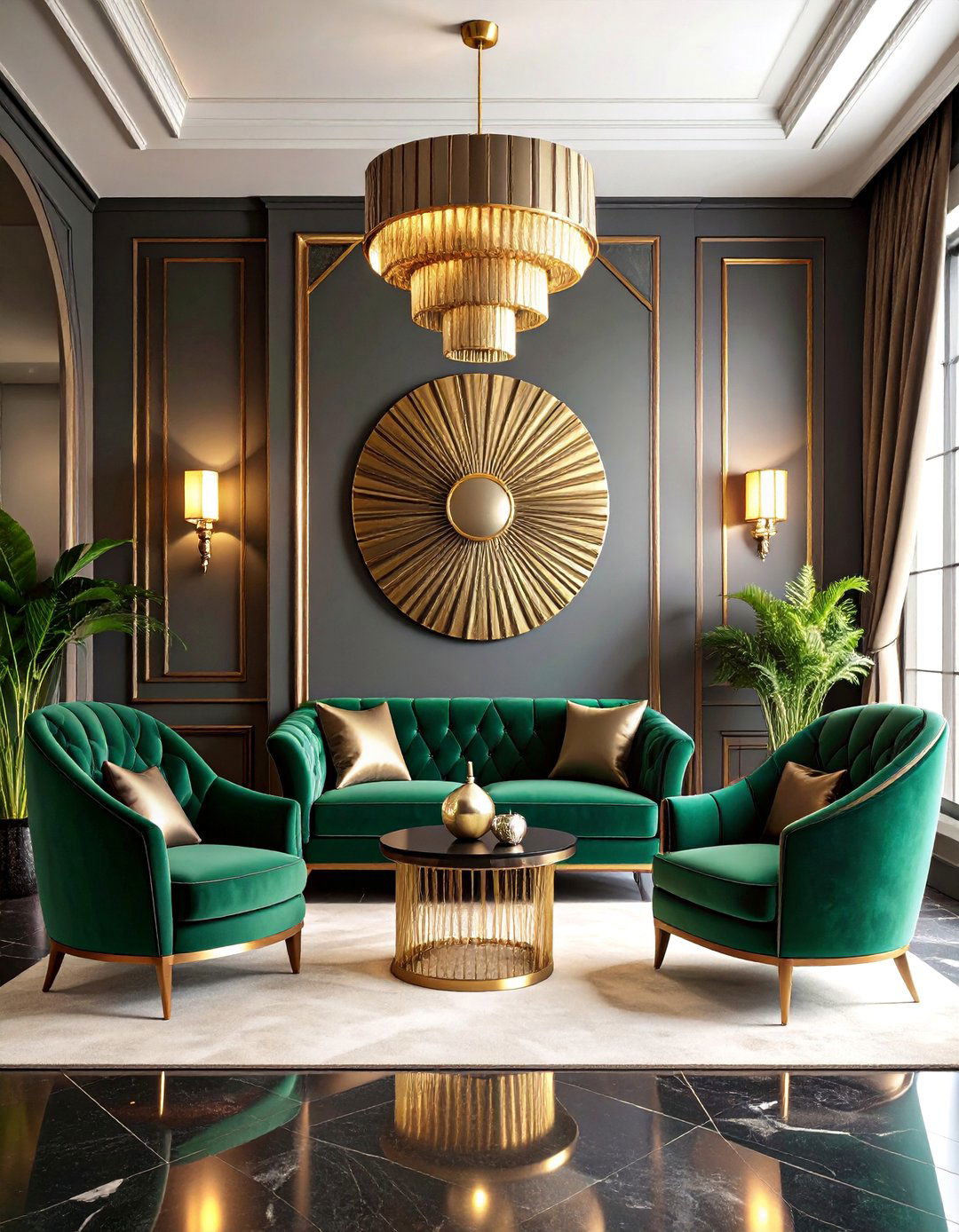
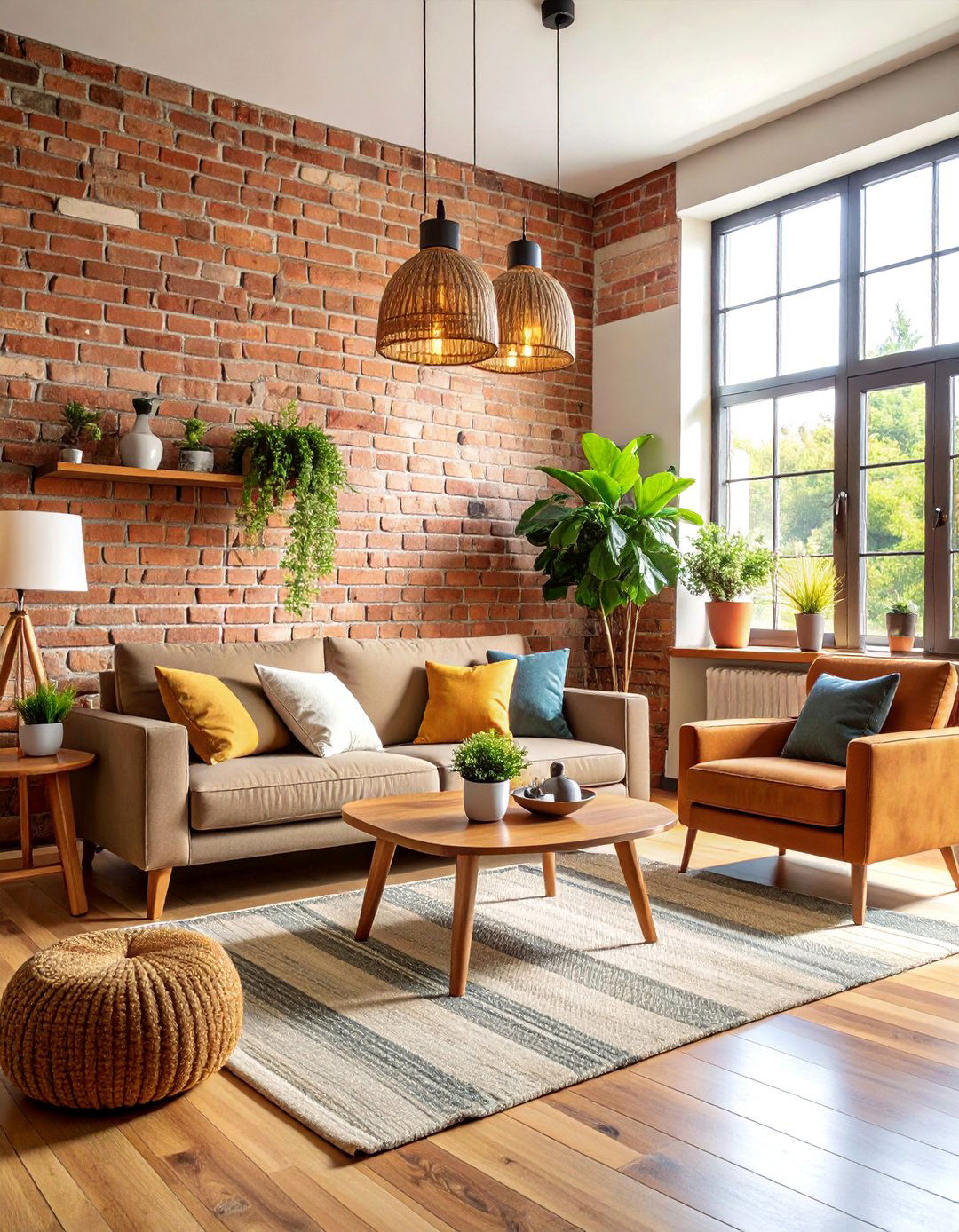

Leave a Reply